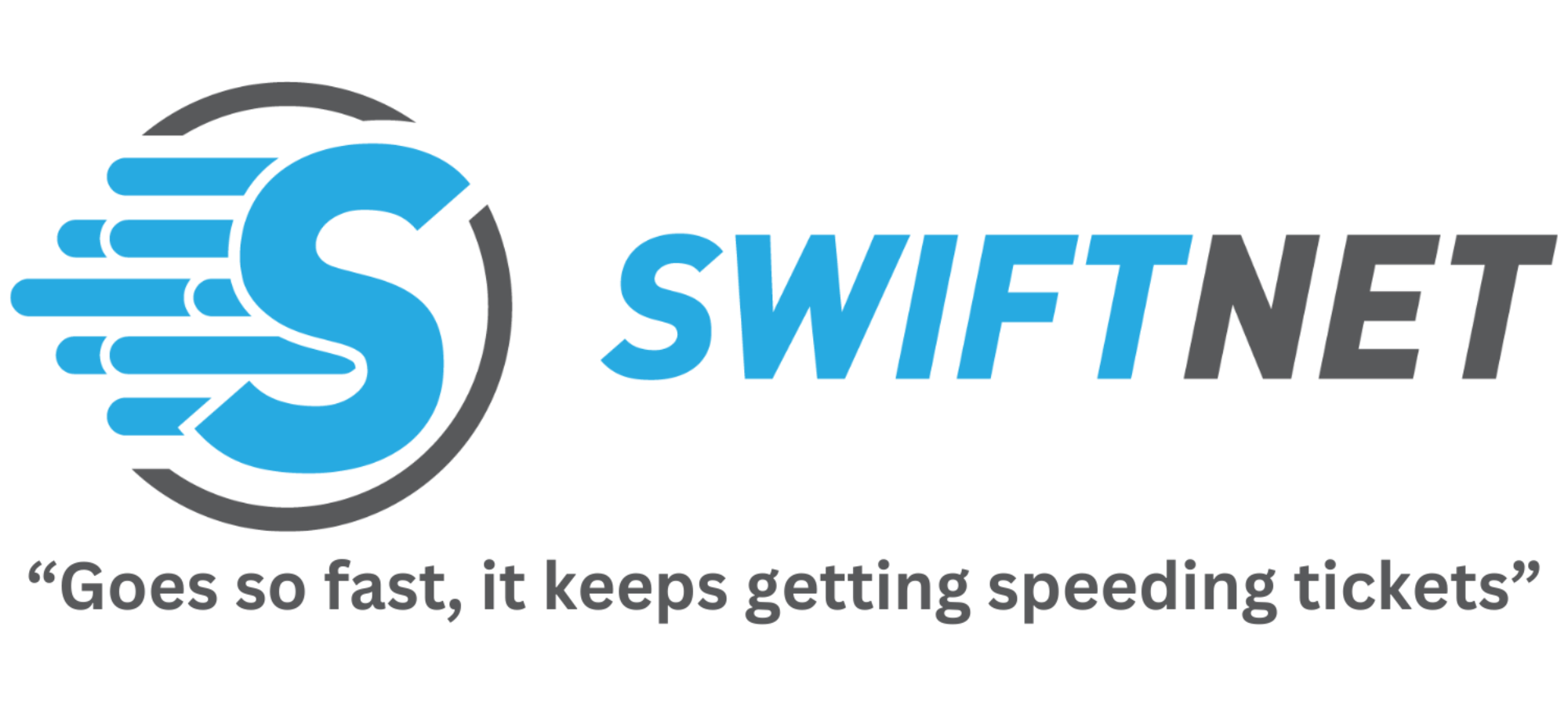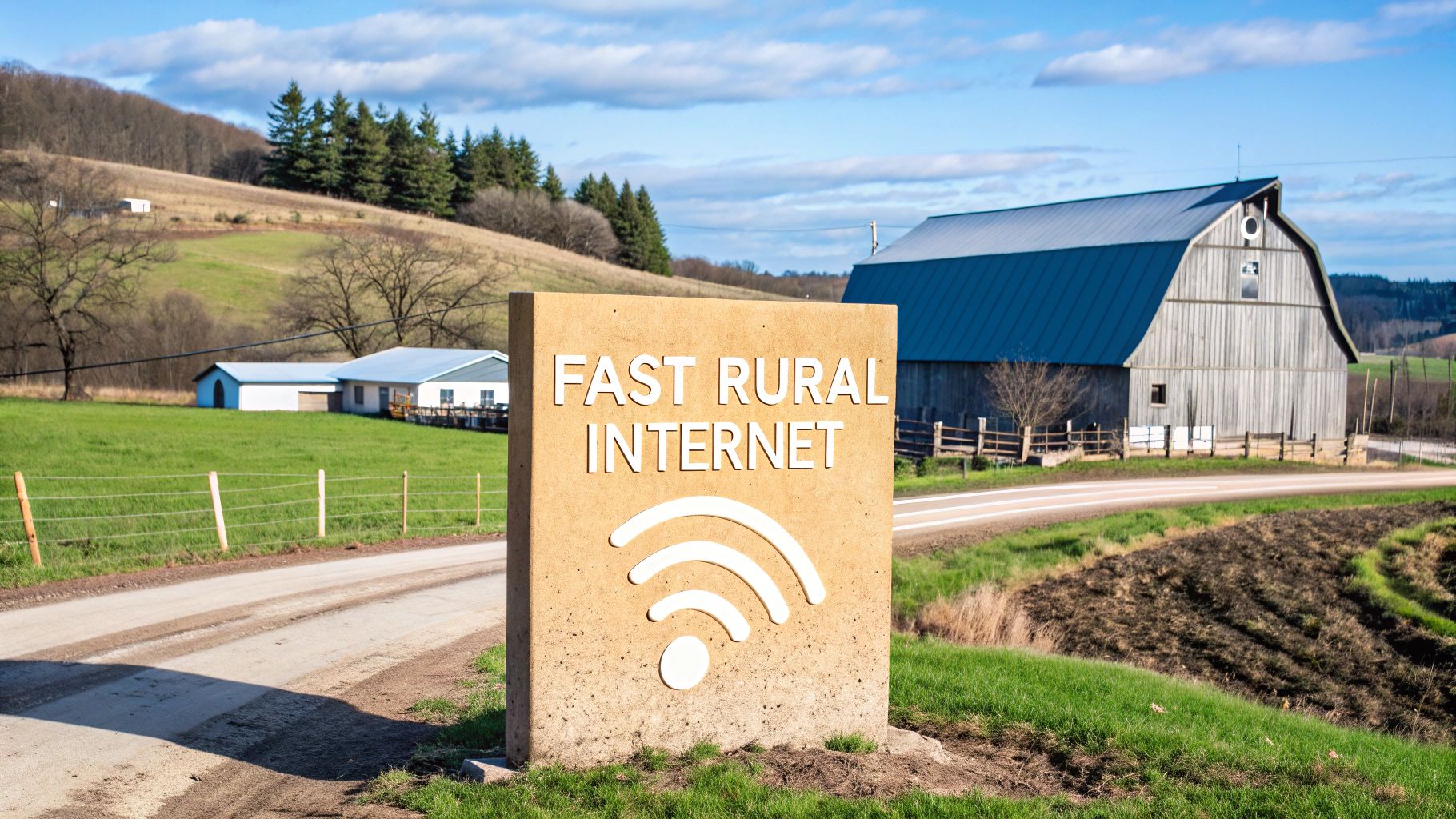

· By James
7 Rural High Speed Internet Options for Remote Areas in 2025
Connecting the Unconnected: Your Guide to Rural Internet in 2025
Finding reliable rural high-speed internet can be challenging. This list of seven top internet options for 2025 helps you overcome connectivity limitations whether you live in a rural area, travel in an RV, or work remotely. Discover the best solutions for your needs and budget, including Starlink, Viasat, and T-Mobile Home Internet, so you can stay connected no matter your location.
1. SwiftNet Wifi
SwiftNet Wifi is a promising solution for those seeking rural high-speed internet access, specifically targeting residents of rural areas and RV travelers who often face limited connectivity options. Designed to bridge the digital divide, SwiftNet Wifi leverages 5G technology to deliver reliable internet to locations often overlooked by traditional fiber optic providers. Whether you're working remotely from your rural home, streaming movies in your RV, or simply trying to stay connected while traveling, SwiftNet Wifi aims to offer a seamless online experience. It promises to empower users with the ability to work, stream, and communicate effectively, even in the most isolated areas, thanks to its optimized 5G technology delivering superior speed and bandwidth. For those struggling with the limitations of satellite internet or the complete lack of wired connections, SwiftNet Wifi presents itself as a viable alternative for achieving reliable rural high speed internet.
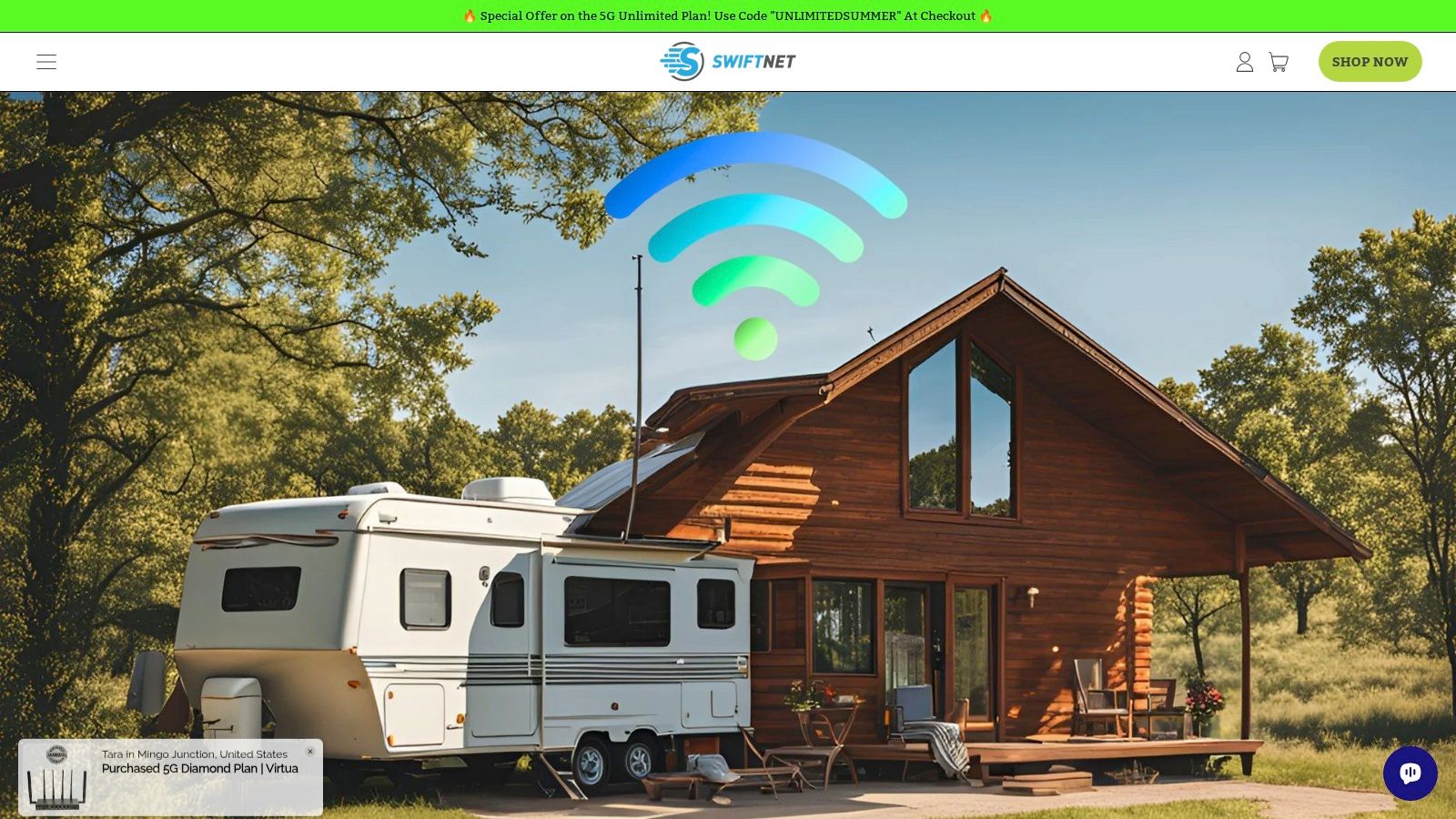
One of the key advantages of SwiftNet Wifi is its focus on mobility. This is particularly beneficial for RV owners who require internet access on the go. Instead of relying on campground Wi-Fi or struggling with inconsistent cellular data, SwiftNet Wifi provides a dedicated connection that travels with you. This allows for continuous connectivity, enabling remote work, entertainment streaming, and staying in touch with family and friends regardless of your location. For rural residents, SwiftNet Wifi offers a potential escape from the limitations of DSL or satellite internet, providing faster speeds and greater reliability. It specifically targets areas where traditional ISPs fall short, effectively bridging the digital divide and bringing essential internet access to underserved communities.
While the specific technical requirements are not readily available, SwiftNet Wifi's reliance on 5G suggests users will need a compatible 5G device or modem. Unfortunately, pricing information is not publicly accessible, requiring potential customers to contact SwiftNet Wifi directly for a quote. This lack of transparency regarding pricing is a notable drawback, making it difficult to compare costs with other rural high-speed internet providers. Furthermore, as with any 5G service, coverage quality and speed can vary depending on the specific rural or remote location and the availability of local 5G network infrastructure. Potential users should inquire about coverage availability in their specific area before committing to the service.
Despite the lack of upfront pricing information, SwiftNet Wifi earns its place on this list because it directly addresses the challenges of obtaining rural high-speed internet, offering a potentially game-changing solution for those living and working in remote areas. Its commitment to serving both stationary rural residents and mobile RV travelers sets it apart, offering a unique solution tailored to the specific needs of these often-underserved groups. If you're seeking reliable rural high speed internet and fall within their coverage area, SwiftNet Wifi is certainly worth investigating further. Visit their website at https://swiftnetwifi.com to learn more and request a quote.
2. Starlink
For those seeking reliable rural high-speed internet, Starlink emerges as a powerful contender, particularly valuable for users beyond the reach of traditional terrestrial internet options. Leveraging a network of low Earth orbit (LEO) satellites, Starlink delivers broadband internet access with significantly lower latency than legacy satellite internet services. This makes it an attractive solution for RV travelers, rural homeowners, remote workers, and anyone needing consistent online access in areas lacking fiber optic infrastructure.
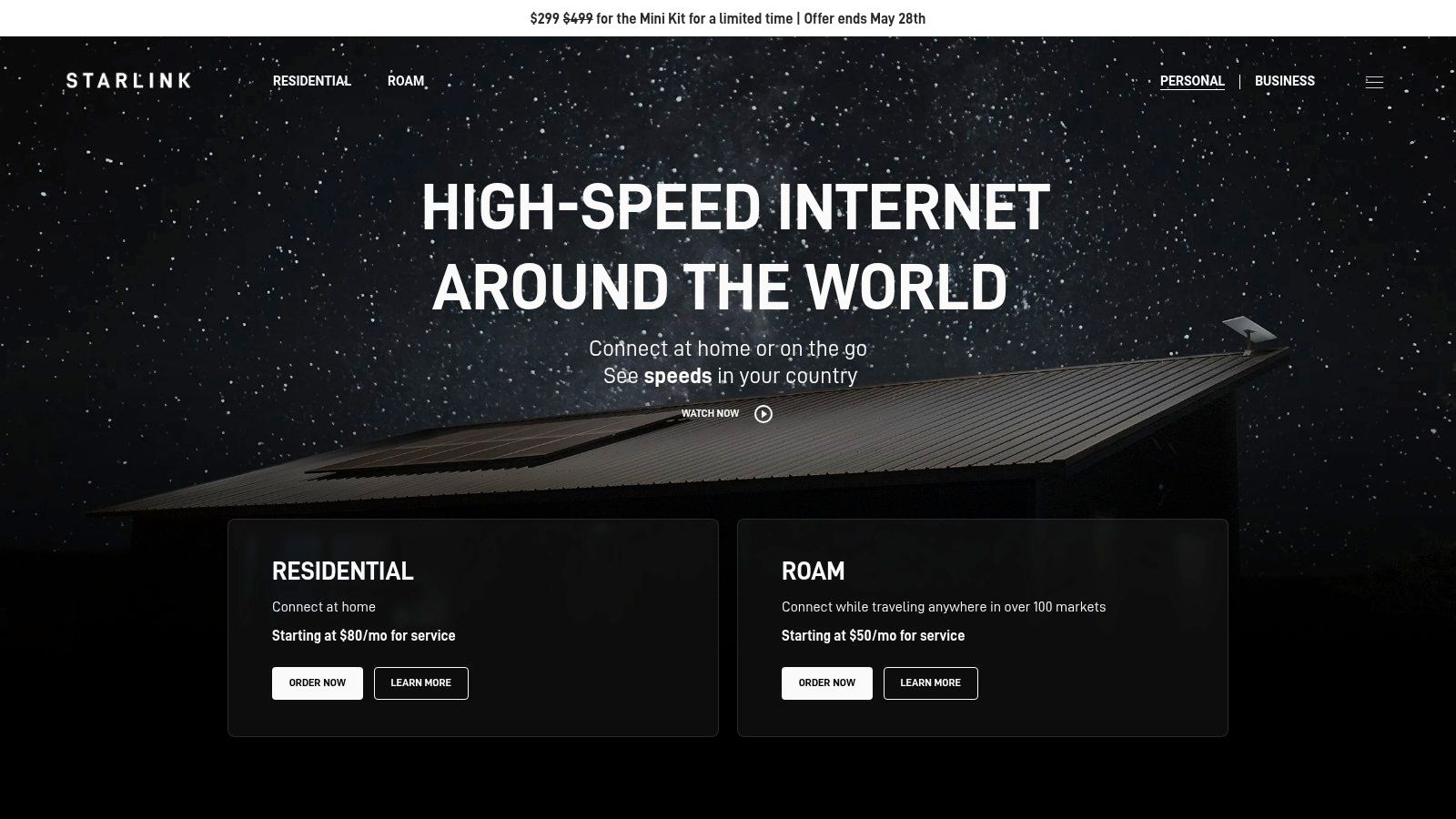
Starlink’s impressive download speeds of 100-300 Mbps and latency as low as 20-40ms make activities like video conferencing, online gaming, and streaming high-definition content a reality, even in the most remote locations. The absence of data caps on most plans provides users with the freedom to use the internet extensively without worrying about overage charges. This is a crucial advantage for those who rely heavily on the internet for work or entertainment. The self-install equipment is designed for user-friendliness, though an unobstructed view of the sky is crucial for optimal performance. Furthermore, its global coverage capabilities empower digital nomads and travelers to stay connected virtually anywhere their adventures take them.
For RV owners and travelers, Starlink provides a consistent internet experience regardless of location, eliminating the hassle of searching for Wi-Fi hotspots or dealing with unreliable cellular data. For those living in rural areas without fiber optics, Starlink offers a viable alternative to slow DSL or expensive fixed wireless options. The lack of contracts offers flexibility, allowing users to pause or cancel their service as needed. This is particularly beneficial for RV travelers who may only require internet access during certain parts of the year.
While Starlink brings many advantages, there are some considerations. The upfront equipment cost of $599 for the standard kit represents a significant initial investment. The monthly service fee of $110-$120 is relatively expensive compared to some terrestrial internet options, though the performance and availability in remote areas often justify the cost. Performance can be affected by adverse weather conditions such as heavy rain or snow. Occasional outages, though becoming less frequent as Starlink continues to expand its satellite constellation, are still a possibility.
Implementation Tip: Before purchasing Starlink, use the Starlink app to check for obstructions and determine the optimal placement for your dish. Ensure you have a clear view of the sky, free from trees and buildings, to maximize performance and minimize interruptions.
Starlink earns its place on this list because it delivers on the promise of rural high-speed internet, bridging the digital divide and providing a reliable connection to those who need it most. Visit the Starlink website (https://www.starlink.com) for more information and to check availability in your area.
3. Viasat
Viasat stands out as a leading satellite internet provider, offering a viable solution for rural high speed internet access across the United States. It effectively bridges the connectivity gap in areas where traditional cable and fiber optic internet options are unavailable, making it a valuable tool for RV travelers, rural homeowners, remote workers, and anyone needing reliable internet access outside of densely populated areas. Viasat offers a range of plans with varying speeds and data allowances designed to meet diverse needs, from casual browsing to demanding online work and streaming. This makes it a strong contender for those seeking reliable connectivity in remote locations.
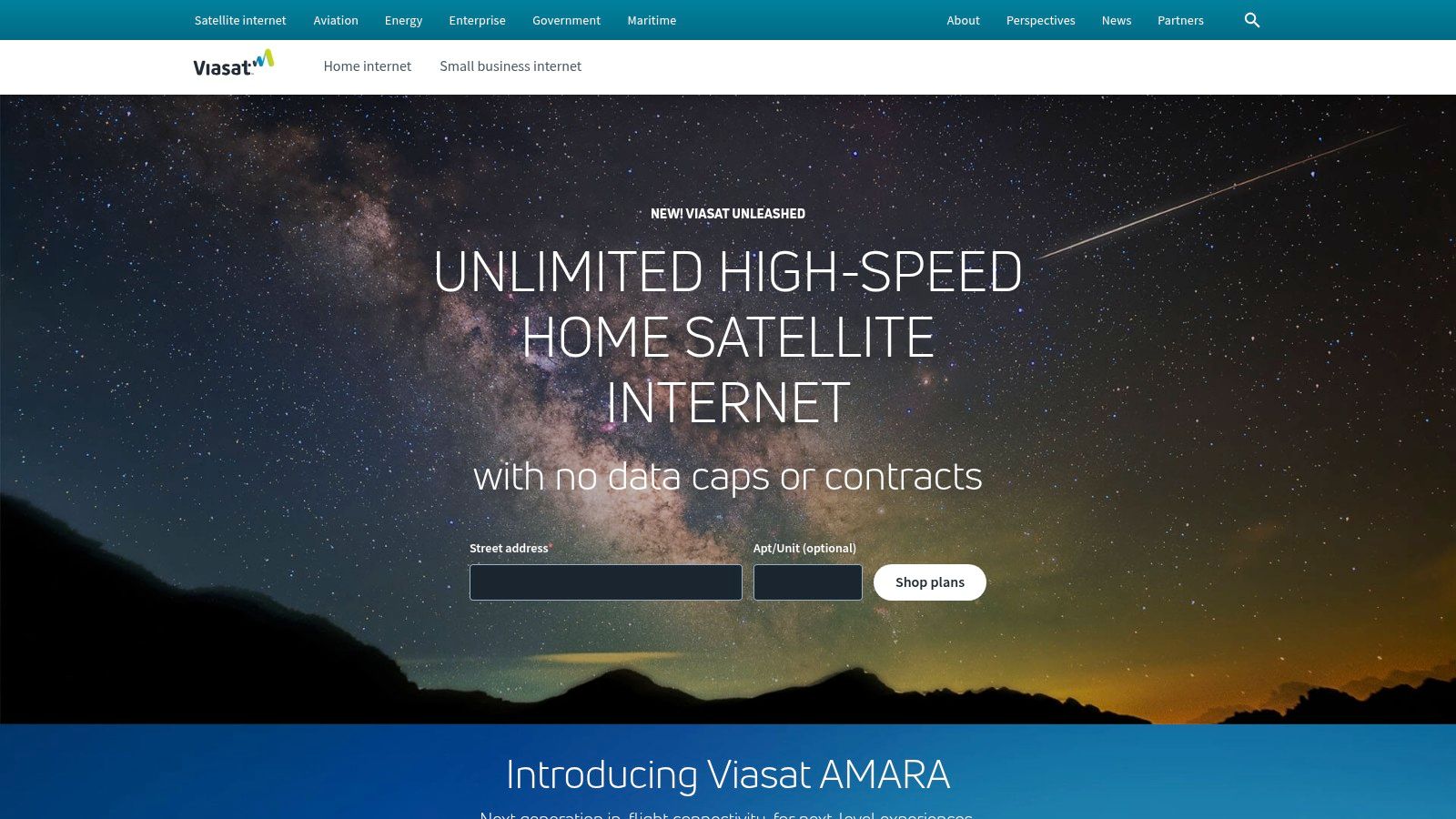
Viasat's satellite technology beams broadband internet directly to your location, eliminating the need for ground-based infrastructure. This widespread availability is a major advantage for those in rural communities. Features include download speeds up to 100 Mbps in select areas, data plans ranging from 40GB to 300GB per month, and a built-in WiFi router with advanced security features. Professional installation is included, ensuring a hassle-free setup process. For users in some areas, Viasat even offers bundle options with DirecTV, streamlining entertainment and internet services. You can Learn more about Viasat and compare it with other rural internet options.
While pricing varies depending on the chosen plan, it's important to be aware that prices typically increase after the promotional period, and a two-year contract is usually required. Although Viasat doesn't enforce hard data caps, speeds may be reduced after exceeding your monthly data allowance, especially during peak usage times. Another key consideration is latency, which is typically higher (600-800ms) than terrestrial options like cable and fiber. This can impact activities that require real-time responsiveness, such as online gaming and video conferencing. However, for general web browsing, streaming, and email, Viasat provides a dependable rural high speed internet solution where other options may be limited or nonexistent.
For RV travelers and remote workers, Viasat's wide coverage area makes it a particularly attractive option. However, it's crucial to carefully assess your data needs and usage patterns to select the right plan. Consider factors like the number of devices you'll be connecting, the types of online activities you'll be engaging in (streaming, video conferencing, etc.), and the potential impact of data throttling during peak hours. By understanding the strengths and limitations of Viasat, you can make an informed decision about whether it's the right rural high speed internet solution for your specific requirements. Visit the Viasat website for the most up-to-date information on plans and pricing in your area.
4. HughesNet
For those seeking rural high-speed internet, particularly in remote areas where other options are scarce, HughesNet is a frequently considered choice. As one of America's most established satellite internet providers, HughesNet blankets the continental US, reaching areas where cable and fiber are simply unavailable. This makes it a viable solution for RV travelers, rural homeowners, and remote workers who need consistent connectivity. HughesNet utilizes geostationary satellites, delivering consistent 25 Mbps download speeds regardless of your location within their coverage area. This consistency is a major draw for users in remote locations where terrestrial internet infrastructure is lacking.
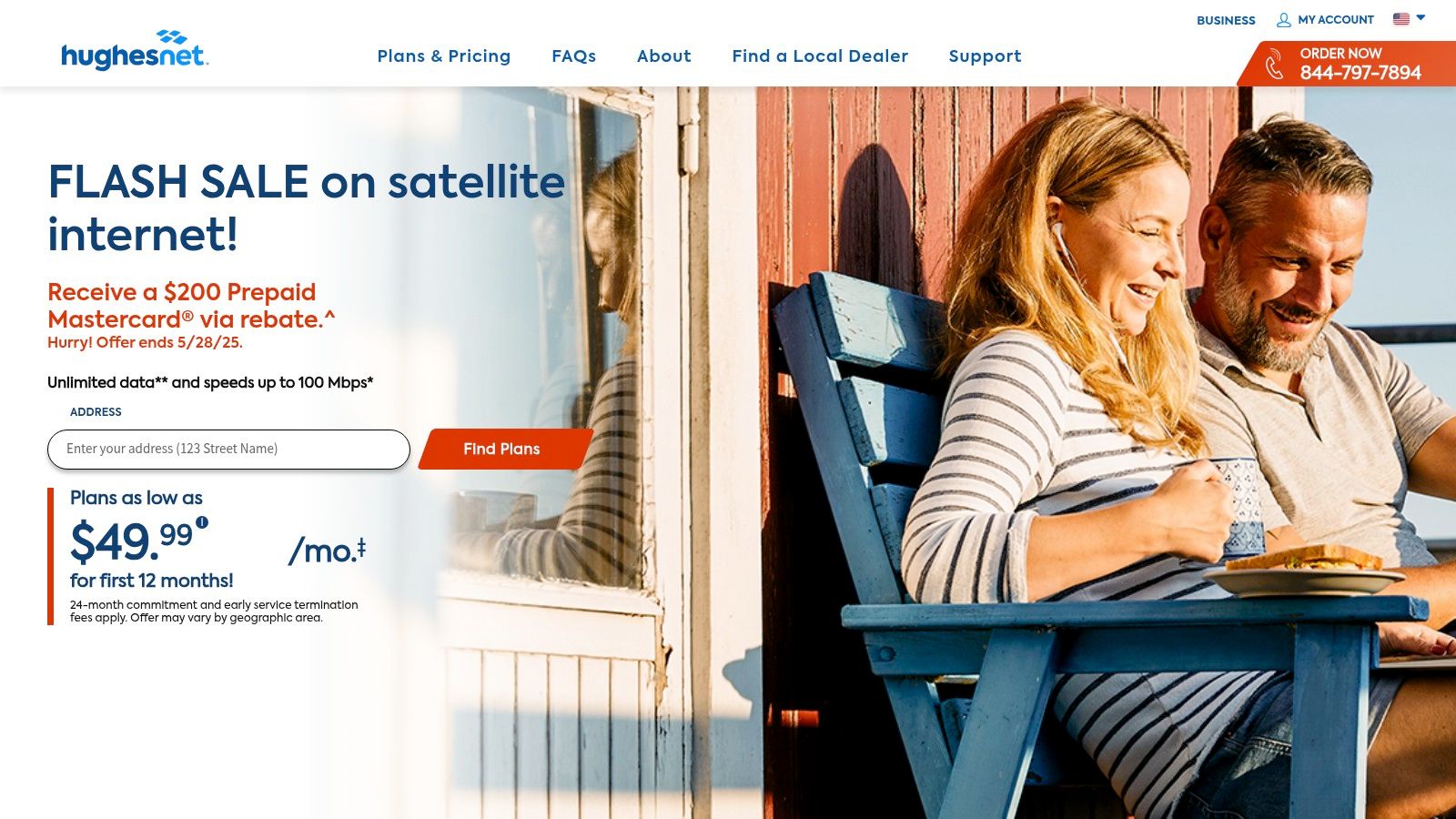
HughesNet offers a variety of data plans, ranging from 15GB to 75GB per month, catering to different usage needs. While 25 Mbps download speeds are consistent across all plans, it's important to understand how these data allowances affect your usage. HughesNet doesn't enforce hard data caps; instead, your speeds are reduced after you exceed your monthly allowance. This means you can still access the internet, but at significantly slower speeds. A key feature is the "Bonus Zone," offering an additional 50GB of data during off-peak hours (2am-8am). This can be beneficial for scheduling large downloads or backups overnight. The straightforward plan structure, combined with free installation and equipment (with a 24-month lease), simplifies the setup process. HughesNet also includes built-in WiFi, further streamlining the installation process for users.
While HughesNet offers extensive coverage and consistent speeds, it's crucial to consider the inherent limitations of satellite internet. High latency (600+ ms) is a significant drawback, impacting real-time applications like video conferencing and online gaming. This latency is due to the signal having to travel to and from the satellite in geostationary orbit. Compared to terrestrial internet options like cable or fiber, satellite internet generally experiences higher latency. The two-year contract requirement might be a concern for some users, especially those looking for short-term or flexible solutions. Additionally, while the data allowances are suitable for some, users with higher bandwidth demands might find them restrictive compared to some competitors. Understanding these pros and cons is essential for making an informed decision about whether HughesNet is the right rural high-speed internet solution for your needs.
Pros:
- Available virtually everywhere in the continental US.
- Consistent 25 Mbps speeds regardless of location.
- No hard data caps (speeds reduce after monthly allowance).
- Simple, straightforward plan structure.
Cons:
- Higher latency (600+ ms) impacts real-time applications.
- Two-year contract requirement.
- Lower data allowances than some competitors.
- Slower speeds after monthly data allowance is used.
Website: https://www.hughesnet.com
5. T-Mobile Home Internet
For those seeking rural high speed internet, T-Mobile Home Internet presents a compelling option leveraging the power of 5G and 4G LTE cellular networks. This fixed wireless solution bypasses the need for traditional cable or fiber optic infrastructure, making it increasingly attractive for rural customers – especially RV travelers, RV owners, remote workers, and those living in areas without fiber optics. Its ease of setup and competitive pricing further solidify its place on this list. Learn more about T-Mobile Home Internet for additional tips on securing internet access in rural locations.
How it Works: T-Mobile Home Internet uses a wireless gateway device to connect your home to the nearest T-Mobile cell tower, delivering internet service through the airwaves. This makes it a plug-and-play solution, ideal for those seeking a hassle-free setup. Simply plug in the gateway, follow the on-screen instructions, and you're online.
Features and Benefits:
- Speed: Typical download speeds range from 35-115 Mbps, which is sufficient for streaming HD video, online gaming, and video conferencing. While this might not match the gigabit speeds of fiber, it's a significant upgrade over satellite internet and many DSL connections often found in rural areas.
- Unlimited Data: Enjoy unlimited data without caps or throttling. This is crucial for rural users who often lack alternatives and rely heavily on their internet connection for work and entertainment.
- Simple Setup: The self-installation process is straightforward with the provided wireless gateway. This eliminates the need for technician visits and allows for quick setup in RVs or remote homes.
- Contract-Free and No Equipment Fees: T-Mobile Home Internet offers the flexibility of no annual contracts and no equipment fees, making it an attractive option for RV travelers and renters.
- Affordable Pricing: A flat-rate price of $50/month with autopay for eligible customers makes it a budget-friendly option compared to other rural internet solutions.
Pros:
- Affordable flat-rate pricing with no hidden fees.
- No data caps or overage charges.
- No equipment costs or long-term contracts.
- Lower latency (20-40ms) compared to satellite internet, making it more responsive for online gaming and video calls.
Cons:
- Limited Availability: Coverage depends on the T-Mobile network, which may be limited in some very remote rural areas. Check the website for availability at your specific location.
- Performance Variation: As with any cellular-based service, performance can vary based on network congestion and signal strength. Speeds may fluctuate throughout the day, especially during peak usage times.
- Not Ideal for Extremely Remote Locations: If you're truly off-grid and far from a cell tower, T-Mobile Home Internet likely won't be a viable option.
Technical Requirements:
The primary requirement is being within T-Mobile's coverage area. You can check availability on their website. Power is required for the gateway device.
Comparison with Similar Tools:
Compared to satellite internet, T-Mobile Home Internet offers lower latency and often higher speeds. Compared to DSL, it often provides faster speeds and unlimited data. However, availability is the key differentiator. If fiber optic internet is available in your area, it will typically offer the fastest speeds and most consistent performance, but at a potentially higher price.
Website: https://www.t-mobile.com/home-internet
T-Mobile Home Internet offers a practical and increasingly viable option for rural high speed internet. Its affordable price, unlimited data, and easy setup make it particularly appealing for those seeking an alternative to traditional wired connections or satellite internet. However, it's crucial to check availability in your area and be aware of the potential for performance fluctuations based on network conditions.
6. AT&T Fixed Wireless
For those seeking rural high speed internet solutions, AT&T Fixed Wireless presents a viable option, particularly for those residing beyond the reach of traditional cable or fiber optic infrastructure. This service leverages cellular technology, making it a practical alternative to satellite internet in eligible rural areas. This makes it an appealing option for RV travelers, RV owners, and those who live and work remotely in areas without fiber optic internet.
AT&T Fixed Wireless utilizes an outdoor antenna installed at the customer's location to connect to AT&T's wireless network. This setup allows for download speeds up to 25 Mbps, sufficient for activities like streaming video and online gaming, although speeds may be lower than some other fixed wireless providers. A monthly data allowance of 350GB is included, with overage charges of $10 per 50GB applying thereafter. Be mindful of this limitation if you're a heavy data user. Professional installation of the outdoor antenna is included, ensuring proper setup and optimal performance. The service is compatible with AT&T's WiFi gateway, facilitating easy home networking. Furthermore, AT&T Fixed Wireless focuses on FCC-defined underserved rural areas, emphasizing its commitment to bridging the digital divide.
Compared to satellite internet, AT&T Fixed Wireless boasts lower latency (30-50ms), leading to a more responsive online experience. It also offers greater stability in adverse weather conditions, a significant advantage in rural environments. Another benefit is the potential for bundling with other AT&T services, which could lead to cost savings. However, a key requirement is a clear line-of-sight to an AT&T cell tower, which can limit availability depending on your specific location. Learn more about AT&T Fixed Wireless to see how 5G is expanding these capabilities.
Implementation Tips:
- Check Availability: Before committing, verify service availability at your precise location through the AT&T website.
- Assess Data Needs: Evaluate your monthly data consumption to determine if the 350GB allowance is sufficient.
- Consider Bundling: Explore potential cost savings by bundling with other AT&T services.
- Prepare for Installation: Ensure clear access to your roof or exterior wall for the antenna installation.
Why it deserves its place on the list: AT&T Fixed Wireless stands out as a solid rural high speed internet option due to its relatively stable performance, lower latency than satellite, and focus on serving underserved rural communities. While data caps and line-of-sight requirements are factors to consider, it offers a practical solution for those seeking reliable internet access in areas where traditional broadband isn't feasible.
Website: https://www.att.com/internet/fixed-wireless/
7. Rise Broadband: A Terrestrial Wireless Solution for Rural High-Speed Internet
For those seeking rural high-speed internet beyond the limitations of satellite, Rise Broadband offers a compelling alternative. As the largest fixed wireless internet service provider in the US specializing in rural and suburban areas, Rise Broadband leverages terrestrial wireless technology, presenting a middle ground between the high speeds of fiber/cable and the widespread availability of satellite internet. This makes it an attractive option for RV travelers, RV owners, remote workers, and anyone living in rural areas without fiber optic connectivity.
Instead of relying on distant satellites, Rise utilizes a network of towers that communicate with small receivers installed at customers' homes. This terrestrial approach translates to several practical advantages, particularly for those who work online or rely on the internet for entertainment.
How Rise Broadband Works and Its Benefits:
Rise Broadband offers a variety of plans with download speeds ranging from 25-50 Mbps in most areas, accommodating various needs, from casual browsing to video streaming and online gaming. Data plans range from 250GB to unlimited, catering to different usage patterns. One significant advantage of their unlimited plans is the absence of hard data caps, ensuring uninterrupted service even during peak usage. The service also includes professional installation of the roof-mounted receiver, ensuring optimal signal strength. For those seeking bundled services, Rise Broadband also offers voice options.
Key Features and Advantages:
- Lower Latency: Compared to satellite internet, Rise Broadband boasts significantly lower latency, typically between 30-60ms. This is crucial for real-time applications like video conferencing, online gaming, and VoIP calls.
- Affordability: Rise Broadband is often a more budget-friendly option than comparable satellite internet plans, making it attractive for those seeking rural high-speed internet without breaking the bank.
- Weather Resistance: Unlike satellite internet, which can be affected by heavy rain or snow, Rise Broadband's terrestrial wireless connection is less susceptible to weather disruptions, ensuring more reliable connectivity.
- No Hard Data Caps: Unlimited data plans truly are unlimited, with no throttling or overage charges, allowing for worry-free internet usage.
Considerations Before Choosing Rise Broadband:
- Limited Coverage: While Rise Broadband serves 16 states, primarily in rural regions, its coverage area is not as extensive as nationwide satellite providers. Check their website (https://www.risebroadband.com) to confirm availability in your specific location.
- Tower Proximity Dependence: Service quality is directly influenced by the distance between your home and the nearest Rise Broadband tower. Obstructions like dense foliage or hills can also impact performance.
- Installation Fees: Professional installation is required, and associated fees may apply. Inquire about specific installation costs when contacting Rise Broadband.
- Performance Variability: Actual speeds and performance can fluctuate based on location, terrain, and network congestion.
Setup and Implementation:
Rise Broadband requires professional installation, which involves mounting a receiver on your roof. This ensures optimal signal reception. Contact Rise Broadband directly to schedule an installation appointment and discuss specific requirements for your location.
Rise Broadband earns its place on this list by offering a viable rural high-speed internet solution that bridges the gap between expensive and limited satellite internet and the often-unavailable fiber optic connections. Its focus on rural communities, coupled with its terrestrial wireless technology, provides a reliable and relatively affordable way to stay connected in areas where other options fall short. For those within their coverage area, Rise Broadband presents a strong contender for bringing high-speed internet to rural homes and businesses.
7 Rural Internet Service Comparison
| Strategy | Implementation Complexity 🔄 | Resource Requirements ⚡ | Expected Outcomes 📊 | Ideal Use Cases 💡 | Key Advantages ⭐ |
|---|---|---|---|---|---|
| SwiftNet Wifi | Moderate — requires 5G network access and compatible devices | Moderate — access to 5G infrastructure, specialized for mobile/rural users | High-speed, reliable 5G connectivity optimized for rural and mobile users | RV travelers, remote workers, rural residents needing better 5G internet | Reliable 5G coverage in underserved rural & remote areas; mobile optimized |
| Starlink | Moderate — self-installation, requires clear sky view | High — upfront equipment cost and monthly fee | High-speed satellite internet with lower latency (20-40ms) | Rural/remote users with no terrestrial alternatives & clear sky | Global coverage, low latency, no data caps, works almost anywhere |
| Viasat | Moderate — professional installation usually required | Moderate to high — professional install and variable plans | Broadband with varying speeds up to 100 Mbps, data caps apply | Rural customers needing higher data allowances than traditional satellite | Wide coverage, higher data limits, bundle options |
| HughesNet | Moderate — professional installation with equipment lease | Moderate — includes equipment lease, contracts apply | Consistent 25 Mbps speeds with data limits and off-peak bonus data | Rural households requiring consistent, basic-speed internet | Nationwide coverage, simple plan structure, off-peak data bonus |
| T-Mobile Home Internet | Low — self-install with wireless gateway device | Low — no equipment fees, flat monthly rate | 35-115 Mbps speeds, unlimited data, low latency (20-40ms) | Rural areas with T-Mobile coverage seeking affordable fixed wireless | Affordable pricing, no data caps, no long-term contracts |
| AT&T Fixed Wireless | Moderate — professional install of outdoor antenna | Moderate — installation needed, data limits apply | Up to 25 Mbps speed, 350GB data allowance, lower latency (30-50ms) | Rural homes needing stable fixed wireless with FCC focus | More stable than satellite in weather, bundling options available |
| Rise Broadband | Moderate — professional installation with roof receiver | Moderate — installation fees may apply | 25-50 Mbps speeds, data plans including unlimited, low latency (30-60ms) | Rural/suburban customers preferring fixed wireless over satellite | Lower latency and weather susceptibility, affordable with unlimited data |
Staying Connected: Making the Right Choice for Your Rural Internet Needs
Choosing the best rural high-speed internet plan isn't a one-size-fits-all endeavor. As we've explored, factors like budget, desired speeds, data limits, and even your geographic location play a crucial role in determining which option is right for you. This article has highlighted seven key providers—SwiftNet Wifi, Starlink, Viasat, HughesNet, T-Mobile Home Internet, AT&T Fixed Wireless, and Rise Broadband—each offering unique advantages and disadvantages for those seeking reliable rural high-speed internet. Remember the key takeaways: research availability in your area, compare pricing and data plans, and consider your specific usage needs (streaming, video conferencing, online gaming, etc.).
For those looking to manage or troubleshoot their rural internet connection effectively, having the right tools is essential. Resources like top remote IT support tools from Screendesk can empower you to resolve issues quickly and maintain a consistent connection.
Implementing your chosen solution also requires some forethought. For satellite internet options like Starlink, Viasat, and HughesNet, consider professional installation for optimal performance. For fixed wireless and mobile internet options like T-Mobile Home Internet and AT&T Fixed Wireless, understanding coverage maps and potential signal limitations is critical. With a little research and planning, you can overcome the challenges of rural connectivity and enjoy seamless online access.
Don't let limited options hold you back. Embrace the advancements in rural high-speed internet and find the solution that unlocks a world of possibilities, from remote work and education to entertainment and staying connected with loved ones. Looking for a reliable and flexible rural internet solution designed for those on the go? Check out SwiftNet Wifi, a provider dedicated to keeping you connected wherever your adventures take you.

